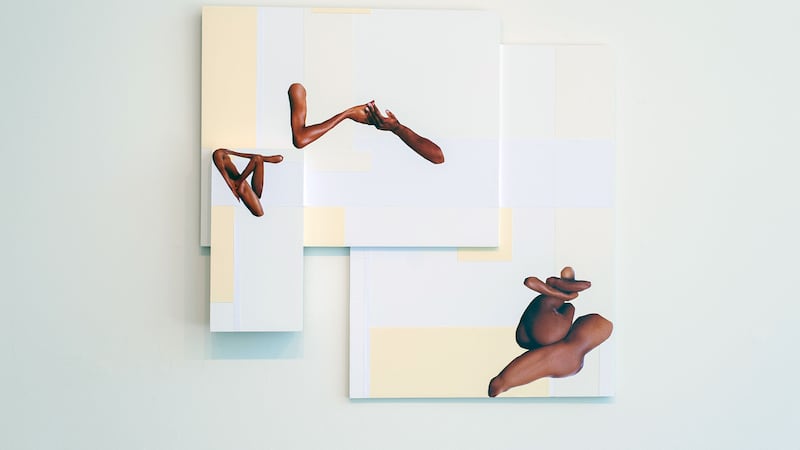Sitting in sagging vintage chairs at Anna Bannanas in St. John's, the two curators behind the Nat Turner Project explain why their collaboration is named after the 1831 slave rebellion leader.
"We wanted to make noise" says maximiliano, co-founder of NTP, which is dedicated to works by artists of color. "We wanted to disrupt."
So it's strange how empty and almost serene their new show at c3:initiative's gallery space initially seems. In the main gallery, there's a TV mounted on a wall playing a video installation; hanging from the ceiling in a far corner, there's a bag of blood-red apples sagging from a net made of hair. But the rest of the works in Jaleesa Johnston's Territories of (E/e)nlightenment—six sparse collages on white and beige canvas—almost blend into the walls. Sharyll Burroughs' interactive Reintegration, is tucked behind a heavy black curtain in a small room off the main gallery space.
Related: Sharyll Burroughs turns racist imagery and words into a lesson.
But the bareness is kind of a meditative—you can give each work your full attention without running out of brain juice before you've reached the end of the exhibit. Plus, it's totally intentional. "How much space a work gets I feel like speaks to the value of that work and the gravity it's considered with," says NTP's other founder Melanie Stevens.
According to Stevens and maximiliano (both recent graduates of one of PNCA's MFA programs), artists of color in Portland don't usually that kind of space. "When you're an artist of color, there's this idea that identity art has to be packaged a certain way," says Stevens.
As Steven puts it, NTP formed out of a desire to "create this environment so that one artist of color does not have to represent an entire barrage of voices." That means giving the artists of color they work with as much freedom as possible, and not exclusively presenting their art as "identity art." So the odd location of their first show (which opened last August), was almost ideal—the works were displayed in a PNCA bathroom. An upperclassman started the tradition, and when he graduated, NTP took over. "He tried to imitate a white box gallery," says maximiliano. "We wanted to be like 'Here's this unconventional space, what can you do with it?'"
In honor of Juneteenth (the celebration of the abolition of slavery), both of the artists in the first of NTP's two shows at c3 are black women. Burroughs' Reintigration has a simple premise: Participants can walk into to the dim room one at a time, where Burroughs sits at a table with a chess clock on it. Projected on the wall behind her is a photo of two figurines constructed according to Plantation-era South stereotypes, gilded in gold and enlarged to take up half the wall. She instructs the participant that they're going to say the n-word back and forth for two minutes. The chess clock is for those who choose to tap out.
Johnston's series of collages are at first unassuming and almost surreal: They depict bodies that are headless, and sometimes just reduced to just legs and arms. But they begin to feel like they're giving off a kind of desperation. They're so close to being vibrant and intimate, but the bodies are fractured in a way that seems to intentionally deprive them of the humanity they'd otherwise achieve. On one of the canvases, two disembodied arms reach out to touch hands.
Related: PNCA's MFA exhibits have a lot to say.
When the duo behind NTP talk about creating space for artists of color, they seamlessly transition from talking about physical space and conceptual freedom. "Discomfort is our mission," says maximiliano, "But I don't know if I would necessarily say that all our shows are about discomfort, because it's still the artist's agenda and what they want."
"Stripping away the pressure to be one voice representing all of the voices," adds Stevens, "is I think the biggest disruption that you can make in this environment—letting works by an artist of color stand on their own."
SEE IT: The June Show is at c3:initiative, 7526 N Chicago Ave., c3initiative.org. Through July 1.
